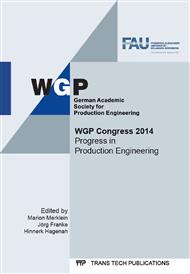[1]
S. Padhi, S. Wagner, T. Niranjan, V. Aggarwal, A simulation-based methodology to analyse production line disruptions, in: International Journal of Production Research (2013).
DOI: 10.1080/00207543.2012.720389
Google Scholar
[2]
H. Carvalho, V. Machado, Fuzzy set theory to establish resilient production systems, in: IIE Annual Conference and Exhibition (2006).
Google Scholar
[3]
M. Meyer, M. Apostu, K. Windt, Analyzing the Influence of Capacity Adjustments on Performance Robustness in Dynamic Job-shop Environments, in: K. Windt (Ed. ), Lecture Notes in Production Engineering: Robust Manufacturing Control, Springer, (2013).
DOI: 10.1016/j.procir.2013.06.014
Google Scholar
[4]
M. Monauni, M. Meyer, K. Windt, Evaluation Model for Robustness and Efficiency Trade-Offs in Production Capacity Decisions in Turbulent Markets, in: K. Windt (Ed. ), Lecture Notes in Production Engineering: Robust Manufacturing Control, Springer, (2013).
DOI: 10.1007/978-3-642-30749-2_39
Google Scholar
[5]
M. Meyer, K. Windt, Lean um jeden Preis? – Interdisziplinäre Methoden als Lösungsansätze für den Positionierungskonflikt zwischen Effizienz und Robustheit, in: Kongressband 2011 zum 28. Deutscher Logistik-Kongress, (2011).
Google Scholar
[6]
S. Saad, N. Gindy, Handling internal and external disturbances in responsive manufacturing environments, in: Production Planning & Control (1998).
DOI: 10.1080/095372898233533
Google Scholar
[7]
H. Beyer, B. Sendhoff, Robust optimization - a comprehensive survey, in: Computer methods in applied mechanics and engineering, 196, 3190-3218. (2007).
DOI: 10.1016/j.cma.2007.03.003
Google Scholar
[8]
Verein Deuscher Ingenieuere (VDI), Sicherheitstechnische Begriffe für Automatisierungssysteme Zuverlässigkeit und Sicherheit komplexer Systeme (Begriffe), in: VDI Richtlinie 3542, S. 1–17. (2000).
Google Scholar
[9]
G. Dellino, J. Kleijnen, C. Meloni, Robust optimization in simulation: Taguchi and Krige combined, in: INFORMS Journal on Computing 24, Nr. 3, 471–484. (2012).
DOI: 10.1287/ijoc.1110.0465
Google Scholar
[10]
A. Scholl, Robuste Planung und Optimierung, Springer (2001).
Google Scholar
[11]
V. Guigues, Robust production management, in: Optimization and Engineering, 10(4), 505–532, (2009).
Google Scholar
[12]
T. Bauernhansl, J. Mandel, S. Diermann, Evaluating Changeability Corridors for Sustainable Business Resilience, in: Procedia CIRP, 3, 364–369, (2012).
DOI: 10.1016/j.procir.2012.07.063
Google Scholar
[13]
J. Kleijnen, E. Gaury, Short-term robustness of production management systems: A case study, in: European journal of operational research, 148(2), 452–465, (2003).
DOI: 10.1016/s0377-2217(02)00437-x
Google Scholar
[14]
S. Fischer, D. Popitz, Effizientes Störungsmanagement für komplexe Produktionssysteme, in: Productivity Management 15, Heft 3, S. 16–19. (2010).
Google Scholar
[15]
T. Kohstall, Instrumente zum Bewerten betrieblicher Störungen - mit Ausfallkostenkalkulator und Checklisten zur Störungsbewertung, in: iga-Report 6. Vollständig überarbeitete Ausgabe (2011).
Google Scholar
[16]
E. Gutenberg, Grundlagen der Betriebswirtschaftslehre – Erster Band; Die Produktion. 18., neu bearbeitete Auflage, Springer (1971).
Google Scholar
[17]
H. Fischäder, H. Schneider, Störparameter im Materialfluss und in Produktionssystemen, in: Dickmann, Philipp (Hrsg. ): Schlanker Materialfluss - mit Lean Production, Kanban und Innovationen. 2. aktualisierte und erweiterte Auflage, Springer, S. 294–297. (2009).
DOI: 10.1007/978-3-540-79515-5_1
Google Scholar
[18]
VDMA 66412-1: 2009-10 Manufacturing Execution Systems (MES) Kennzahlen, Beuth Verlag, (2009).
Google Scholar


